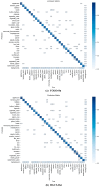HGCS-Det: A Deep Learning-Based Solution for Localizing and Recognizing Household Garbage in Complex Scenarios
- PMID: 40573613
- PMCID: PMC12196681
- DOI: 10.3390/s25123726
HGCS-Det: A Deep Learning-Based Solution for Localizing and Recognizing Household Garbage in Complex Scenarios
Abstract
With the rise of deep learning technology, intelligent garbage detection provides a new idea for garbage classification management. However, due to the interference of complex environments, coupled with the influence of the irregular features of garbage, garbage detection in complex scenarios still faces significant challenges. Moreover, some of the existing research suffer from shortcomings in either their precision or real-time performance, particularly when applied to complex garbage detection scenarios. Therefore, this paper proposes a model based on YOLOv8, namely HGCS-Det, for detecting garbage in complex scenarios. The HGCS-Det model is designed as follows: Firstly, the normalization attention module is introduced to calibrate the model's attention to targets and to suppress the environmental noise interference information. Additionally, to weigh the attention-feature contributions, an Attention Feature Fusion module is employed to complement the attention weights of each channel. Subsequently, an Instance Boundary Reinforcement module is established to capture the fine-grained features of garbage by combining strong gradient information with semantic information. Finally, the Slide Loss function is applied to dynamically weight hard samples arising from the complex detection environments to improve the recognition accuracy of hard samples. With only a slight increase in parameters (3.02M), HGCS-Det achieves a 93.6% mean average precision (mAP) and 86 FPS on the public HGI30 dataset, which is a 3.33% higher mAP value than from YOLOv12, and outperforms the state-of-the-art (SOTA) methods in both efficiency and applicability. Notably, HGCS-Det maintains a lightweight architecture while enhancing the detection accuracy, enabling real-time performance even in resource-constrained environments. These characteristics significantly improve its practical applicability, making the model well suited for deployment in embedded devices and real-world garbage classification systems. This method can serve as a valuable technical reference for the engineering application of garbage classification.
Keywords: Slide Loss; attention-feature fusion; garbage detection; instance boundary reinforcement; normalization attention.
Conflict of interest statement
The authors declare no conflicts of interest.
Figures












Similar articles
-
DASNet a dual branch multi level attention sheep counting network.Sci Rep. 2025 Jul 2;15(1):23228. doi: 10.1038/s41598-025-97929-w. Sci Rep. 2025. PMID: 40603607 Free PMC article.
-
SODU2-NET: a novel deep learning-based approach for salient object detection utilizing U-NET.PeerJ Comput Sci. 2025 May 19;11:e2623. doi: 10.7717/peerj-cs.2623. eCollection 2025. PeerJ Comput Sci. 2025. PMID: 40567673 Free PMC article.
-
Integrating computer vision algorithms and RFID system for identification and tracking of group-housed animals: an example with pigs.J Anim Sci. 2024 Jan 3;102:skae174. doi: 10.1093/jas/skae174. J Anim Sci. 2024. PMID: 38908015 Free PMC article.
-
Home treatment for mental health problems: a systematic review.Health Technol Assess. 2001;5(15):1-139. doi: 10.3310/hta5150. Health Technol Assess. 2001. PMID: 11532236
-
Immunogenicity and seroefficacy of pneumococcal conjugate vaccines: a systematic review and network meta-analysis.Health Technol Assess. 2024 Jul;28(34):1-109. doi: 10.3310/YWHA3079. Health Technol Assess. 2024. PMID: 39046101 Free PMC article.
References
-
- Kaza S., Yao L., Bhada-Tata P., Van Woerden F. What a Waste 2.0: A Global Snapshot of Solid Waste Management to 2050. World Bank Publications; Washington, DC, USA: 2018.
-
- Lowe D.G. Distinctive Image Features from Scale-Invariant Keypoints. Int. J. Comput. Vis. 2004;60:91–110. doi: 10.1023/B:VISI.0000029664.99615.94. - DOI
-
- Dalal N., Triggs B. Histograms of Oriented Gradients for Human Detection; Proceedings of the 2005 IEEE Computer Society Conference on Computer Vision and Pattern Recognition (CVPR’05); San Diego, CA, USA. 20–25 June 2005.
Grants and funding
LinkOut - more resources
Full Text Sources
Miscellaneous

